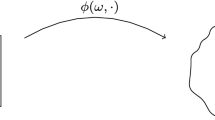Abstract
In this article, we provide a rigorous analysis of the solution to elliptic diffusion problems on random domains. In particular, based on the decay of the Karhunen-Loève expansion of the domain perturbation field, we establish decay rates for the derivatives of the random solution that are independent of the stochastic dimension. For the implementation of a related approximation scheme, like quasi-Monte Carlo quadrature, stochastic collocation, etc., we propose parametric finite elements to compute the solution of the diffusion problem on each individual realization of the domain generated by the perturbation field. This simplifies the implementation and yields a non-intrusive approach. Having this machinery at hand, we can easily transfer it to stochastic interface problems. The theoretical findings are complemented by numerical examples for both, stochastic interface problems and boundary value problems on random domains.










Similar content being viewed by others
Notes
It is sufficient to assume that \(\mathbf{V}\) is a \(C^1\)-diffeomorphism and satisfies the uniformity in \({C^1(\overline{D_{\mathrm{ref}}};\mathbb {R}^d)}\). Nevertheless, in order to obtain \(H^2\)-regularity of the model problem, we make this stronger assumption.
With “formally” we mean that we ignore here the fact that the product of matrices is in general not Abelian. Nevertheless, a differentiation yields exactly the appearing products in a permuted order. The formal representation is justified since we only consider the norm of the representation in the sequel.
Each node consists of two quad-core Intel(R) Xeon(R) X5550 CPUs with a clock rate of 2.67GHz (hyperthreading enabled) and 48GB of main memory.
References
Abramowitz, M., Stegun, I.A.: Handbook of Mathematical Functions: With Formulas, Graphs, and Mathematical Tables. Applied mathematics series. Dover Publications, N. Chemsford (1964)
Alt, H.W.: Lineare Funktionalanalysis. Springer, London (2007)
Beck, J., Tempone, R., Nobile, F., Tamellini, L.: On the optimal polynomial approximation of stochastic pdes by galerkin and collocation methods. Math. Models Methods Appl. Sci. 22(9), 1250023 (2012)
Braess, D.: Finite Elemente: Theorie Schnelle Löser und Anwendungen in der Elastizitätstheorie. Springer, London (2007)
Canuto, C., Kozubek, T.: A fictitious domain approach to the numerical solution of PDEs in stochastic domains. Numerische Mathematik 107(2), 257–293 (2007)
Castrillon-Candas, J.E., Nobile, F., Tempone, R.F.: Analytic regularity and collocation approximation for PDEs with random domain deformations. ArXiv e-prints 1312.7845 (2013)
Chen, Z., Zou, J.: Finite element methods and their convergence for elliptic and parabolic interface problems. Numerische Mathematik 79(2), 175–202 (1998)
Cohen, A., DeVore, R., Schwab, C.: Convergence rates of best \(N\)-term Galerkin approximations for a class of elliptic sPDEs. Found. Comput. Math. 10, 615–646 (2010)
Constantine, G.M., Savits, T.H.: A multivariate Faà di Bruno formula with applications. Trans. Am. Math. Soc. 248, 503–520 (1996)
Ghanem, R., Spanos, P.: Stochastic finite elements: A spectral approach. Springer, New York (1991)
Griebel, M., Harbrecht, H.: Approximation of bi-variate functions: singular value decomposition versus sparse grids. IMA J. Numer. Anal. 34(1), 28–54 (2014)
Gross, O.A.: Preferential arrangements. Am. Math. Month. pp. 4–8 (1962)
Halton, J.H.: On the efficiency of certain quasi-random sequences of points in evaluating multi-dimensional integrals. Numerische Mathematik 2(1), 84–90 (1960)
Harbrecht, H., Li, J.: First order second moment analysis for stochastic interface problems based on low-rank approximation. ESAIM. Math. Model. Numer. Anal. 47, 1533–1552 (2013)
Harbrecht, H., Peters, M., Schneider, R.: On the low-rank approximation by the pivoted Cholesky decomposition. Appl. Numer. Math. 62, 28–440 (2012)
Harbrecht, H., Peters, M., Siebenmorgen, M.: On the quasi-Monte Carlo method with Halton points for elliptic PDEs with log-normal diffusion. Preprint 2013-28, Mathematisches Institut Universität Basel (to appear in Mathematics of Computation) (2013)
Harbrecht, H., Peters, M., Siebenmorgen, M.: Efficient approximation of random fields for numerical applications. Numer. Linear Algebra Appl. 22(4), 596–617 (2015)
Harbrecht, H., Schneider, R., Schwab, C.: Sparse second moment analysis for elliptic problems in stochastic domains. Numerische Mathematik 109(3), 385–414 (2008)
Holmes, R.B.: Smoothness of certain metric projections on Hilbert space. Trans. Am. Math. Soc. 184, 87–100 (1973)
Kadison, R.V., Ringrose, J.R.: Fundamentals of the theory of operator algebras. V1: Elementary theory. Academic Press, New York (1986)
Kuo, F.Y., Schwab, C., Sloan, I.H.: Quasi-Monte Carlo methods for high-dimensional integration: the standard (weighted Hilbert space) setting and beyond. ANZIAM J. 53, 1–37 (2012)
Lenoir, M.: Optimal isoparametric finite elements and error estimates for domains involving curved boundaries. SIAM J. Numer. Anal. 23(3), 562–580 (1986)
Li, J., Melenk, J.M., Wohlmuth, B., Zou, J.: Optimal a priori estimates for higher order finite elements for elliptic interface problems. Appl. Numer. Math. 60(1), 19–37 (2010)
Light, W.A., Cheney, E.W.: Approximation theory in tensor product spaces. Lecture notes in mathematics Volume 1169. Springer, New York (1985)
Loève, M.: Probability theory. I+II, Graduate Texts in Mathematics, vol. 45, 4th edn. Springer, New York (1977)
Mohan, P.S., Nair, P.B., Keane, A.J.: Stochastic projection schemes for deterministic linear elliptic partial differential equations on random domains. Int. J. Numer. Methods Eng. 85(7), 874–895 (2011)
Niederreiter, H.: Random number generation and Quasi-Monte Carlo methods. Society for Industrial and Applied Mathematics, Philadelphia (1992)
Nobile, F., Tempone, R., Webster, C.G.: An anisotropic sparse grid stochastic collocation method for partial differential equations with random input data. SIAM J. Numer. Anal. 46(5), 2411–2442 (2008)
Schwab, C., Todor, R.: Karhunen-Loève approximation of random fields by generalized fast multipole methods. J. Comput. Phys. 217, 100–122 (2006)
Simon, B.: Methods of modern mathematical physics: functional analysis, vol. 1. Academic Press, San Diego (1980)
Simon, J.: Differentiation with respect to the domain in boundary value problems. Numer. Funct. Anal. Optim. 2(7–8), 649–687 (1980)
Sokołowski, J., Zolésio, J.P.: Introduction to shape optimization. Shape sensitivity analysis. Springer series in computational mathematics. Springer, Berlin Heidelberg (1992)
Tartakovsky, D.M., Xiu, D.: Stochastic analysis of transport in tubes with rough walls. J. Comput. Phys. 217(1), 248–259 (2006)
Wang, X.: A constructive approach to strong tractability using quasi-Monte Carlo algorithms. J. Complex. 18, 683–701 (2002)
Wilf, H.S.: Generating functionology. A. K. Peters Ltd, Natick (2006)
Xiu, D., Tartakovsky, D.M.: Numerical methods for differential equations in random domains. SIAM J. Sci. Comput. 28(3), 1167–1185 (2006)
Author information
Authors and Affiliations
Corresponding author
Additional information
This research has been supported by the Swiss National Science Foundation (SNSF) through the project “Rapid Solution of Boundary Value Problems on Stochastic Domains”.
Appendix
Appendix
Lemma 8
Let \({\varvec{\gamma }}=\{\gamma _k\}_k\in \ell ^1(\mathbb {N})\) with finite support \(\mathcal {I}\subset \mathbb {N}\) and \(\gamma _k\ge 0\). Moreover, assume that \(c_{\varvec{\gamma }}\mathrel {\mathrel {\mathop :}=}\sum _{k\in \mathcal {I}}\gamma _k<1\). Then, it holds
and therefore there exists a constant with \(|{\varvec{\alpha }}|!/{\varvec{\alpha }}!{\varvec{\gamma }}^{\varvec{\alpha }}\le c\) for all \({\varvec{\alpha }}\in \mathbb {N}^M_0\), where we set \(M\mathrel {\mathrel {\mathop :}=}|\mathcal {I}|\) and \(0^0=1\).
Proof
It holds
by the multinomial theorem and the limit of the geometric series. \(\Box \)
Lemma 9
Let \(c,m\in \mathbb {R}\) with \(m\ge 2\) and \(c\ge m/(m-1)\). It holds for \(n\in \mathbb {N}\) that
Proof
It holds
Omitting the second summand together with the condition \(c\ge m/(m-1)\) yields the assertion. \(\Box \)
Rights and permissions
About this article
Cite this article
Harbrecht, H., Peters, M. & Siebenmorgen, M. Analysis of the domain mapping method for elliptic diffusion problems on random domains. Numer. Math. 134, 823–856 (2016). https://doi.org/10.1007/s00211-016-0791-4
Received:
Revised:
Published:
Issue Date:
DOI: https://doi.org/10.1007/s00211-016-0791-4




